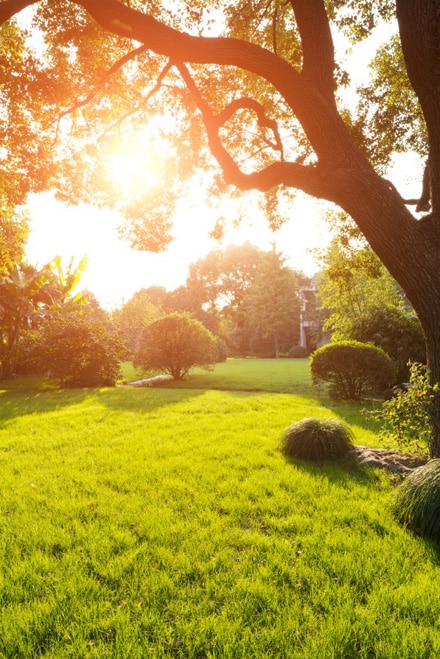However, trees and turf grass can be grown together successfully if they are designed, installed and maintained in a manner where they do not excessively compete for resources.
Excessive shade from the trees can cause the grass growing under them to become sparse. Bermuda grass cannot tolerate shade, but tall fescue, zoysia, and St. Augustine are tolerant to filtered shade. Turf should not be planted at all in deep shade. As an alternative, install shade tolerant shrubs, groundcovers, perennials or just apply mulch.
The equipment used in maintaining the grass can cause tree damage by scraping the trunks and branches. It can also compact the soil resulting in root damage. Compaction reduces the infiltration of water and air into the soil that can lead to damage and death of the tree roots. Trees growing in compacted soil are more susceptible to pest infestations and environmental stresses.
Turf growing under trees in shadier conditions requires less fertilizer than grass in full sun. Trees should be fertilized separately by placing tree fertilizer in the ground by the tree root zone. The fertilizer applied to turfgrasses usually does not harm trees. The grass will utilize it. Also, many chemical pesticides, especially herbicides, commonly applied on lawns can be harmful to trees if absorbed by their roots. Refer to the pesticides labels to find out if their chemicals have the potential to harm the trees.
Trees prefer deep, infrequent watering that penetrates down into their root zones. Shallow watering for turf grasses is not beneficial to trees, and water applications rates to reach tree roots are often excessive for grass. Water from the sprinklers striking the trunk and accumulating at its base can cause rot. Adjust the sprinkler heads to minimize the amount of water from coming into contact with the tree trunk. Ideally, trees and turf should be designed and installed in different irrigation zones.
For grass growing under trees and in shady areas, raise the mowing height. The taller growing grass blades can then compete efficiently with the tree roots for nutrients and water.
Designate turf free areas of the landscape under the canopies of trees. Apply mulch, like wood chips and pine straw, to areas under the tree and the surrounding area. Do not pile it at the base of the trunk, which can lead to rot. Mulched areas will also reduce the chances of equipment from coming into contact with the trees and also reduce compaction.
Practicing proper cultural management techniques will improve chances of their ability to grow near each other. Even though they can be competitive, both trees and turf can survive and thrive if given the proper care.
Timothy Daly, is an Agricultural and Natural Resource Extension Agent with Gwinnett County. He can be contacted at 678-377-4010 or tdaly@uga.edu


